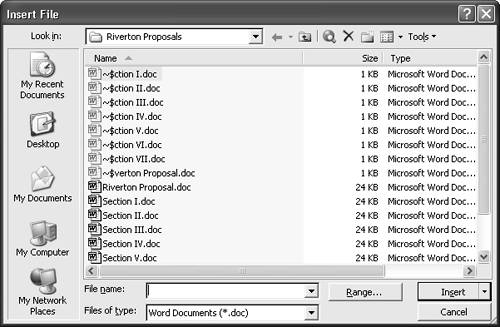Inserting Files Rather Than Using Master Documents
If you need to include some or all of the contents of multiple Word files in a single document, and you don't need the flexibility that master documents give you, Word offers another option: the Insert File feature. With Insert File, you simply browse to another Word file and insert its contents into the Word file you have open. You can do one of the following:
Insert the contents without establishing a link?essentially copying an entire document into your file, without going through the trouble of opening the file and selecting all its text.
Insert the contents as a link so that changes to the original file can automatically be reflected in the file you're working in.
Inserting an Entire File
The most common use for Insert File is to insert the entire contents of a file. Follow these steps to do so:
Click where you want to insert a file.
Choose Insert, File. The Insert File dialog box appears (see Figure 19.11).
Figure 19.11. Inserting a file from the Insert File dialog box.

Browse to the file you want to insert and select it.
If you simply want to insert the file's text without creating a link, click the Insert button. If you prefer to create a link, click the down arrow to the right of the Insert button, and choose Insert as Link.
NOTE
If you're inserting a file that doesn't use Word's current file format (for example, a file from an older version of Word, such as Word 95 or Word 6, or from a competitive word processor such as WordPerfect), Word attempts to convert it first. If the file can be converted, Word inserts it. If not, Word displays an error message.
For more information on Word's capability to convert documents from WordPerfect files, go to www.microsystems.com/PDFS/whitepaper.pdf.
If you insert the file using a link, Insert File actually inserts an { INCLUDETEXT } field in your document that includes a reference to the document you inserted. As with master documents, you can reflect the latest information in the source document, though the process is slightly less automatic. You have to select the field and press F9 to update it, just as you would with any other Word field.

Insert File also lets you build tables of contents, indexes, and cross-references that take into account the text from another document. One major difference, however, limits the usefulness of Insert File: You can't click the field to open and edit the file you've inserted.
You can, however, edit the text you've inserted. After you do, you can press Ctrl+Shift+F7 to update the source document so that it reflects your edits.







